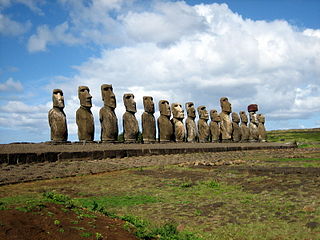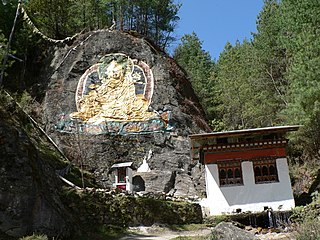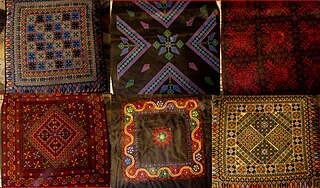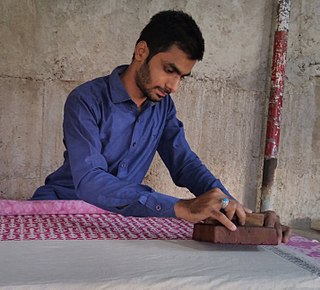
Bethlehem is a city in the Israeli-occupied West Bank, Palestine, located about 10 kilometres (6.2 mi) south of Jerusalem. It is the capital of the Bethlehem Governorate, and has a population of approximately 25,000 people. The city's economy is largely tourist-driven; international tourism peaks around and during Christmas, when Christians embark on a pilgrimage to the Church of the Nativity, revered as the location of the Nativity of Jesus.

A handicraft, sometimes more precisely expressed as artisanal handicraft or handmade, is any of a wide variety of types of work where useful and decorative objects are made completely by one's hand or by using only simple, non-automated related tools like scissors, carving implements, or hooks. It is a traditional main sector of craft making and applies to a wide range of creative and design activities that are related to making things with one's hands and skill, including work with textiles, moldable and rigid materials, paper, plant fibers, clay, etc. One of the oldest handicraft is Dhokra; this is a sort of metal casting that has been used in India for over 4,000 years and is still used. In Iranian Baluchistan, women still make red ware hand-made pottery with dotted ornaments, much similar to the 5,000-year-old pottery tradition of Kalpurgan, an archaeological site near the village. Usually, the term is applied to traditional techniques of creating items that are both practical and aesthetic. Handicraft industries are those that produce things with hands to meet the needs of the people in their locality without using machines.

Wood carving is a form of woodworking by means of a cutting tool (knife) in one hand or a chisel by two hands or with one hand on a chisel and one hand on a mallet, resulting in a wooden figure or figurine, or in the sculptural ornamentation of a wooden object. The phrase may also refer to the finished product, from individual sculptures to hand-worked mouldings composing part of a tracery.

Stone carving is an activity where pieces of rough natural stone are shaped by the controlled removal of stone. Owing to the permanence of the material, stone work has survived which was created during our prehistory or past time.

Beit Jala is a Palestinian Christian town in the Bethlehem Governorate of Palestine, in the West Bank. Beit Jala is located 10 km (6.2 mi)10 km south of Jerusalem, on the western side of the Hebron road, opposite Bethlehem, at 825 meters (2,707 ft) altitude. In 2017, Beit Jala had 13,484 inhabitants according to the Palestinian Central Bureau of Statistics. About 80% of the population were Christians and about 20% Muslims.

Alebrijes are brightly colored Mexican folk art sculptures of fantastical (fantasy/mythical) creatures.

Folk art covers all forms of visual art made in the context of folk culture. Definitions vary, but generally the objects have practical utility of some kind, rather than being exclusively decorative. The makers of folk art are typically trained within a popular tradition, rather than in the fine art tradition of the culture. There is often overlap, or contested ground with 'naive art'. "Folk art" is not used in regard to traditional societies where ethnographic art continue to be made.

Beit Sahour or Beit Sahur is a Palestinian town east of Bethlehem, in the Bethlehem Governorate of the State of Palestine. The city is under the administration of the Palestinian National Authority. The population was of 13,281 in 2017, consisting of approximately 80% Christians and 20% Muslims.
Traditionalcrafts in Japan have a long tradition and history. Included in the category of traditional crafts are handicrafts produced by an individual or a group, as well as work produced by independent studio artists working with traditional craft materials and/or processes.

A stone sculpture is an object made of stone which has been shaped, usually by carving, or assembled to form a visually interesting three-dimensional shape. Stone is more durable than most alternative materials, making it especially important in architectural sculpture on the outside of buildings.

Bhutanese art ༼འབྲུག་པའི་སྒྱུ་རྩལ༽ is similar to Tibetan art. Both are based upon Vajrayana Buddhism and its pantheon of teachers and divine beings.

Mother-of-pearl carving is a traditional handicraft in Bethlehem, and is said to have been brought to the city by Franciscan friars from Italy in the 15th century.

Palestinian handicrafts are handicrafts produced by Palestinian people. A wide variety of handicrafts, many of which have been produced by Arabs in Palestine for hundreds of years, continue to be produced today. Palestinian handicrafts include embroidery work, pottery-making, soap-making, glass-making, weaving, and olive-wood and Mother of Pearl carvings, among others. Some Palestinian cities in the West Bank, particularly Bethlehem, Hebron and Nablus have gained renown for specializing in the production of a particular handicraft, with the sale and export of such items forming a key part of each cities' economy.

San Martín Tilcajete is a town and municipality located about 23 kilometres (14 mi) from the city of Oaxaca, in the state of Oaxaca, in the south of Mexico. It is part of the Ocotlán District in the south of the Valles Centrales Region

Artisans Angkor is a Cambodian social business creating job opportunities for young people in rural areas, while reviving traditional Khmer craftsmanship.

The crafts of India are diverse, rich in history, culture and religion. The craft of each state in India reflect the influence of different empires. Throughout centuries, crafts have been embedded as a culture and tradition within rural communities.

Hebron glass refers to glass produced in Hebron as part of a flourishing art industry established in the city during Roman rule in Palestine, but its origin goes back to the older Phoenician glass industry. The Old City of Hebron still contains a quarter named the "Glass-Blower Quarter" and Hebron glass continues to serve as a tourist attraction for the city.

Oaxaca handcrafts and folk art is one of Mexico's important regional traditions of its kind, distinguished by both its overall quality and variety. Producing goods for trade has been an important economic activity in the state, especially in the Central Valleys region since the pre-Hispanic era which the area laid on the trade route between central Mexico and Central America. In the colonial period, the Spanish introduced new raw materials, new techniques and products but the rise of industrially produced products lowered the demand for most handcrafts by the early 20th century. The introduction of highways in the middle part of the century brought tourism to the region and with it a new market for traditional handcrafts. Today, the state boasts the largest number of working artisans in Mexico, producing a wide range of products that continue to grow and evolve to meet changing tastes in the market.

Handicrafts produced during the Qing dynasty (1644–1911) were objects designed and hand-made by craftsmen. They were heavily ornate, incorporating Tibetan, Middle Eastern, Indian, and European techniques. The design or decorative aspect of the craft was as important as the crafting technique itself and Qing artisans were particular about the materials they used, such as jade (yu), stones, and wood. In their designs artisans drew heavily from a number of motifs, both mythical and natural. Certain areas in China became well-known for specific types of handicrafts; for example, Jingdezhen was known as the capital of porcelain. During the Qing era, Imperial Workshops built in Beijing brought together artisans and raw materials that were once only obtainable in disparate regions. This allowed for the combining of technologies and materials to produce new types of handicrafts. The tributary system also brought new sources for materials and artisans that were not from the production centers.

Beer in the State of Palestine is manufactured by Palestinian microbreweries – most traditionally Taybeh Brewery, established in 1994, and Birzeit Brewery, since 2015. Several beer festivals are held annually in Palestine, including an Oktoberfest-style event hosted by the Taybeh Brewery.





















